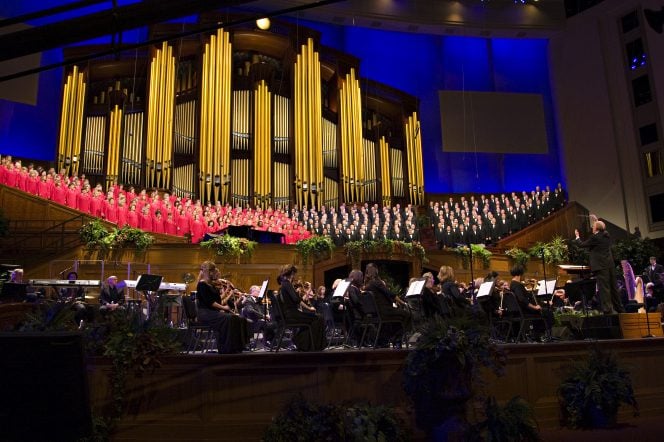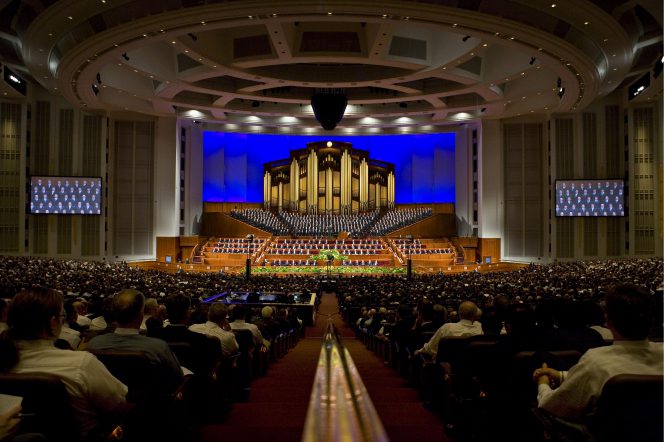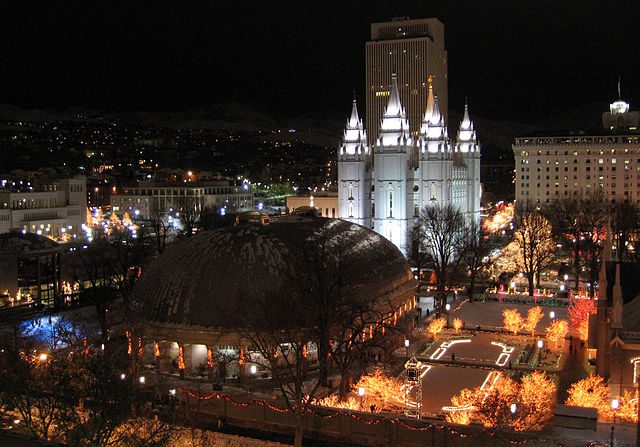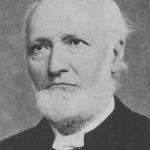
Last night, my wife and I attended the first evening of the annual three-night Christmas with the Tabernacle Choir program in the magnificent and magnificently decorated Conference Center in Salt Lake City. We thoroughly enjoyed it. The special guests this year are Lea Salonga and Sir David Suchet, and they were very good. Every year, the program includes narration of the Nativity story, as recounted in the second chapter of the Gospel of Luke; Sir David did it better, I think, than anybody else I’ve heard heard, in the Tabernacle Choir programs or beyond. He made it fresh, as if he were telling the story for the very first time. At two points in the program, I teared up. This is maybe not so very surprising because, as I descend ever deeper into doddering and sentimental old age, I tear up much more easily than I once did. But it’s still fairly rare. Anyway, one of those moments was when the Choir and the Orchestra at Temple Square performed back to back renditions of two of my very favorite pieces of music: “Lo, How a Rose E’er Blooming” (Es ist ein Ros’ entsprungen) and Pachelbel’s Canon in D (arranged as a choral piece entitled “Hosanna in excelsis”).
My emotional response has historical roots, as well as aesthetic ones: I mentioned here the other day how clearly I recall the first time that I heard Es ist ein Ros’ entsprungen. The same is true for Pachelbel’s Canon in D. It was performed at a Switzerland Zürich Mission reunion many, many years ago, by a string quartet that, I remember, included Kory Katseanes (who had been one of the zone leaders over me when I was in Interlaken) and a fellow-student from Switzerland named Jolanda Przewrocka. I was entranced.
After the concert was over, we drove to the Salt Lake Airport. There, we met our son and his three-year-old daughter, who have come to visit with us from Bogotá, Colombia. Owing to distance and calendars and workloads and, most of all, to COVID-19 and very severe lockdowns in Latin America, this was our first time to see our granddaughter in real life, and not merely via FaceTime. Altogether, a very, very good evening. One to be long remembered and cherished.

These two pieces went up on the website of the Interpreter Foundation today. I hope that you’ll enjoy them:
“We Live in the Olden Days: Reflections on the Importance of Scientific and Theological Humility,” written by Steven L. Clark
Abstract: Members of The Church of Jesus Christ of Latter-day Saints have a unique perspective on truth. Our knowledge that Salvation likely involves participation in complex eternal activities requiring significantly more understanding than we currently possess naturally leads us to seek truth and, in addition, to seek an understanding of that truth. Under these circumstances, our inability to fully understand many truths, both revealed and discovered, can lead to confusion. A lack of complete understanding of accepted scientific truth generally leads the serious truth-seeker to enhanced investigative and educational efforts without doubting the ultimate veracity of the concept under investigation; we all believe in gravity, but no one completely understands it. In a similar manner, the fact that an individual is bothered by such an incompletely understood truth is rarely seen as reason to reject it; gravity bothers me a lot — were it not for gravity, I could fly. Unfortunately, an inability to fully understand some revealed truths all too often leads to rejection of that truth rather than an acceptance of one’s conceptual limitations and an enhanced effort at understanding the concept in question. Such an approach can be as disastrous (although often not as immediately disastrous) as disregard of the reality of gravity. Consideration of examples of both scientific and spiritual experience may lead to a more rational reaction to truths that we do not, and sometimes at our present level of understanding, simply cannot, completely comprehend.
“Interpreting Interpreter: Old-Fashioned Humility,” written by Kyler Rasmussen
This post is a summary of the article ““We Live in the Olden Days: Reflections on the Importance of Scientific and Theological Humility” by Steven L. Clark in Volume 54 of Interpreter: A Journal of Latter-day Saint Faith and Scholarship. An introduction to the Interpreting Interpreter series is available at https://interpreterfoundation.org/interpreting-interpreter-on-abstracting-thought/.
The Takeaway: Clark reminds us that smart people in the past have confidently held beliefs that we now know to be mistaken, a fact which should lead us to treat the confidently held beliefs of the present with patience and humility—including those that appear at odds with church doctrine. The inability to fully understand gospel truths should encourage further investigation of those truths (via both spiritual and scientific means) rather than prompt their immediate rejection and should caution us against making claims that are absent of both empirical and spiritual support.

This is an interesting Jewish take on the editing of the Bible — on the selection of some items and the omission of others. I think, anyway, that some Latter-day Saint readers will enjoy it: “Who Edited Hanukkah Out of the Bible?”
And I’m sympathetic to this suggestion. I myself have led several slightly Christianized Passover seders, and I like the symbolism of Hanukkah: “Jesus Celebrated Hanukkah, So Why Don’t We?”











